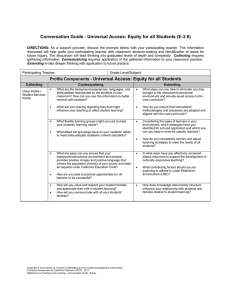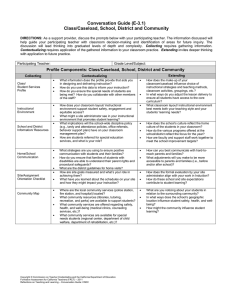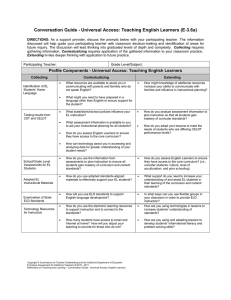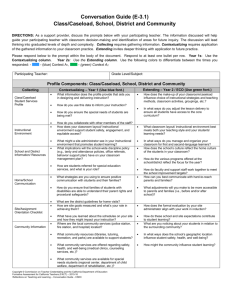Support Provider Discussion Guide Clear Education Specialist Credential
advertisement
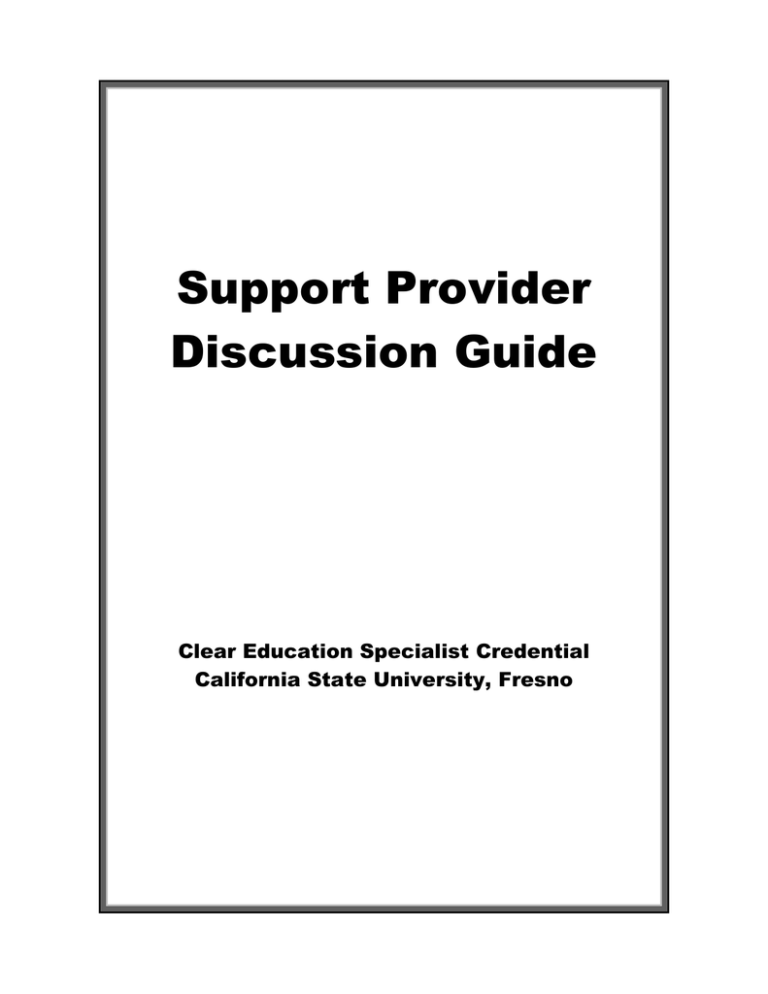
Support Provider Discussion Guide Clear Education Specialist Credential California State University, Fresno Conversation Guide (E-3.1) Class/Caseload, School, District and Community DIRECTIONS: As a support provider, discuss the prompts below with your participating teacher. The information discussed will help guide your participating teacher with classroom decision-making and identification of areas for future inquiry. The discussion will lead thinking into graduated levels of depth and complexity. Collecting requires gathering information. Contextualizing requires application of the gathered information to your classroom practice. Extending invites deeper thinking with application to future practice. Participating Teacher: Grade Level/Subject: Profile Components: Class/Caseload, School, District and Community Collecting Class/ Student Services Profile • • • Instructional Environment • • School and District Information/ Resources • • Home/School Communication • • • Site/Assignment Orientation Checklist Extending Contextualizing • • • Community Map • • • What information does the profile provide that aids you in designing and delivering instruction? How do you use this data to inform your instruction? How do you ensure the special needs of students are being met? How do you collaborate with other members of the staff? • How does your classroom layout/ instructional environment support student safety, engagement and equitable access? What might a site administrator see in your instructional environment that promotes student learning? What implications will the school-wide discipline policy (e.g., tardy and attendance policies, office referrals, behavior support plan) have on your classroom management plan? How are students referred for special education services, and what is your role? • What strategies are you using to ensure positive communication with students and their families? How do you ensure that families of students with disabilities are able to understand their parent rights and procedural safeguards? What are the district guidelines for home visits? How are site goals measured and what’s your role in achieving them? What have you learned about the schedules on your site and how they might impact your instruction? • Where are the local community services (police station, fire station, and hospital) located? What community resources (libraries, tutoring, recreation, and parks) are available to support students? What community services are offered regarding safety, health, and well-being (medical clinics, counseling services, etc.)? What community services are available for special needs students (regional center, department of child welfare, department of rehabilitation, etc.)? • Copyright © Commission on Teacher Credentialing and the California Department of Education Formative Assessment for California Teachers (FACT) – 2011 Reflections on Teaching and Learning – Conversation Guide: CSDC • • • • • • • • • How does the make-up of your classroom/caseload influence choice of instructional strategies and teaching methods, classroom activities, groupings, etc.? In what ways do you adjust the lesson delivery to ensure all students have access to the core curriculum? What classroom layout/ instructional environment best meets both your teaching style and your students’ learning needs? How does the school’s culture reflect the home culture of the students in your classroom? How do the various programs offered at the school/district reflect the focus for the year? How are faculty and support staff work together to meet the school improvement targets? How can you best communicate with hard-toreach parents and families? What adjustments will you make to be more accessible to parents and families (i.e., before and/or after school)? How does the formal evaluation by your site administrator align with your work in Induction? How do these school and site expectations contribute to student learning? What are you noticing about your students in relation to the surrounding community? In what ways does the school’s geographic location influence student safety, health, and wellbeing? How might the community influence student learning? Conversation Guide – Pedagogy (E-3.5) DIRECTIONS: As a support provider, discuss the prompts below with your participating teacher. The information discussed will help guide your participating teacher with classroom decision-making and identification of areas for future inquiry. The discussion will lead thinking into graduated levels of depth and complexity. Collecting requires gathering information. Contextualizing requires application of the gathered information to your classroom practice. Extending invites deeper thinking with application to future practice. Participating Teacher: Grade Level/Subject: Profile Components: Pedagogy Collecting Contextualizing • • How do you allocate instructional time to implement the instructional program? • • How do your routines and procedures provide a fair and respectful climate for student learning? • • How might you adjust instructional time in response to unexpected calendar changes? How do you help your students take ownership for establishing and maintaining a fair and respectful climate for student learning? How will implementation of positive behavioral support plan(s) ensure success for student learning? How do you use your Back to School Night presentation to discuss learning, identify classroom, and academic goals, and build relationships with your students’ parents and families? What can you learn about your students from their parents and families? School Calendar Standards for Student and Classroom Behavior/ Positive Behavioral Support Plans • Parent/Student Communication Instructional Materials (teacher edition, student texts, support materials, enrichment) Pacing Guide/ Curriculum Map/ Scope and Sequence • • What are some examples of how that is working in your classroom? What steps have you taken to establish a learning partnership with your students’ families? • How does a greater understanding of the community aid communication with your students’ family? • How do you use computer applications (grading programs, letters home) to communicate with parents and families regarding grades? • How does communication with parents and families inform your instruction? • What professional development is available to support your subject-matter focus? How can you access available training for your content area? • How are you incorporating new learning received from training into your lesson design and delivery? • • Are your materials appropriate and sufficient? How does your collaboration with other grade level/department teachers influence use of instructional materials and delivery of instruction? • How does the instructional material provide the basis for differentiating instruction? What are some strategies you and your colleagues use to ensure students are actively engaged in appropriately designed instruction? • How can you group your students to use instructional time efficiently? • What impact does the calendar have on your pacing guide/ curriculum map/ scope and sequence? How do you use the data to analyze the learning needs of your students and inform instruction? • Data Program(s) for Student Information Student Strengths Extending How do calendared events (assemblies, testing) influence teaching and learning in my classroom? How can you make optimal use of instructional time? • How do you determine report card grades? • What strategies do you use to identify student strengths? How do you use student strengths to support their learning? Copyright © Commission on Teacher Credentialing and the California Department of Education Formative Assessment for California Teachers (FACT) - 2011 Reflections on Teaching and Learning – Conversation Guide: Pedagogy • • • • How do you and your colleagues address students who are “falling behind” the learning of others? Describe how collaboration with colleagues might result in increased learning for all students? How do you enable your students to recognize and use their strengths to take ownership of their own learning? Conversation Guide - Universal Access: Equity for all Students (E-3.6) DIRECTIONS: As a support provider, discuss the prompts below with your participating teacher. The information discussed will help guide your participating teacher with classroom decision-making and identification of areas for future inquiry. The discussion will lead thinking into graduated levels of depth and complexity. Collecting requires gathering information. Contextualizing requires application of the gathered information to your classroom practice. Extending invites deeper thinking with application to future practice. Participating Teacher: Grade Level/Subject: Profile Components - Universal Access: Equity for all Students Collecting Class Profile / Student Services Profile Contextualizing Extending • What are the background experiences, languages, and skills/abilities represented by the students in your classroom? How can you use this information to better connect with students? • What steps can you take to eliminate any bias brought to the classroom/instructional environment and provide equal access to the core curriculum? • What are you noticing regarding bias that might influence your teaching or affect student learning? • How do you ensure that instructional methodologies and processes are adapted and aligned with the core curriculum? • What flexible learning groups might you use to meet your students’ learning needs? • • What effect will groupings have on your students’ ability to meet state-adopted academic content standards? Considering the types of learners in your environment, which strategies have you identified for a broad application and which one can you keep in mind for specific learners? • How do you consistently monitor and adjust teaching strategies to meet the needs of all students? • In what ways have you effectively accessed district resources to support the development of culturally responsive teaching? • What contributing factors should you be exploring to adhere to Least Restrictive Environment (LRE)? • How does knowledge about family structure influence your relationship with students and families relative to student learning? • What are ways can you ensure that your classroom/instructional environment and practice provides positive images and positive language that mirrors the population diversity of your county and state as required under California Education Code? • How are you able to promote opportunities for all learners to be successful? • How will you value and respect your student families and appreciate their role in student learning? How will you communicate with all your students' families? • Copyright © Commission on Teacher Credentialing and the California Department of Education Formative Assessment for California Teachers (FACT) - 2011 Reflections on Teaching and Learning – Conversation Guide: Equity Conversation Guide - Universal Access: Teaching English Learners (E-3.6a) DIRECTIONS: As a support provider, discuss the prompts below with your participating teacher. The information discussed will help guide your participating teacher with classroom decision-making and identification of areas for future inquiry. The discussion will lead thinking into graduated levels of depth and complexity. Collecting requires gathering information. Contextualizing requires application of the gathered information to your classroom practice. Extending invites deeper thinking with application to future practice. Participating Teacher: Grade Level/Subject: Profile Components - Universal Access: Teaching English Learners Collecting Contextualizing • What resources are available to assist you in communicating with parents and families who do not speak English? • What might you need to have prepared in a language other than English to ensure support for the student? • What state/district/school policies influence your EL instruction? • What assessment information is available to you to aid your instructional planning for all students? Identification of EL Students’ Home Language Testing results from CST and CELDT Extending • How might knowledge of additional resources increase your ability to communicate with families and influence in instructional planning? • How do you analyze assessment information to plan instruction so that all students gain mastery of curricular standards? • How do you adapt your lessons to meet the needs of students who are differing CELDT performance levels? • How do you assess English Learners to ensure they have access to the core curriculum? • How can technology assist you in accessing and analyzing data for greater understanding of your student needs? • How do you use the information from assessments to plan instruction to ensure all students gain mastery of curriculum and content standards? • How do you assess English Learners to ensure they have access to the core curriculum? (i.e., consider students’ culture, level of acculturation, and prior schooling) • How do you use adopted standards-aligned materials to effectively support your EL students? • What support do you need to increase your understanding of and assist EL students in their learning of the curriculum and content standards? • How will you use ELD standards to support English language development? • In what ways can you use flexible groups in your classroom in order to provide ELD instruction? • How do you use the electronic learning resources to support instruction and to connect to the standards? • How are you using technologies in lessons to increase students’ understanding of standards? • How many students have access to email and Internet at home? How will you adjust your teaching to provide for those who do not? • How are you using and adapting lessons to develop students’ informational literacy and problem-solving skills? School/Grade Level Assessments for EL Students. Adopted EL Instructional Materials Examination of State ELD Standards Technology Resources for Instruction Copyright © Commission on Teacher Credentialing and the California Department of Education Formative Assessment for California Teachers (FACT) - 2011 Reflections on Teaching and Learning – Conversation Guide: Universal Access: English Learners Conversation Guide - Universal Access: Teaching Special Populations (E-3.6b) DIRECTIONS: As a support provider, discuss the prompts below with your participating teacher. The information discussed will help guide your participating teacher with classroom decision-making and identification of areas for future inquiry. The discussion will lead thinking into graduated levels of depth and complexity. Collecting requires gathering information. Contextualizing requires application of the gathered information to your classroom practice. Extending invites deeper thinking with application to future practice. Participating Teacher: Grade Level/Subject: Profile Components - Universal Access: Teaching Special Populations Collecting Identification of Class Profile Students: • Health Problems • Individual Education Plans (IEP) • SST Interventions • 504 Plans • Identified as Gifted & Talented (GATE) Student Study Team (SST) Procedure Site Resources Available for Special Populations. Contextualizing • What information are you required to monitor on an ongoing basis for your special needs students’ IEP and SST interventions? • How do you support your special needs students including your GATE students in relation to: • Goals/benchmarks • Modifications, accommodations, variations • IDEA legal requirements • How might you use the pre-referral intervention process to address the academic, behavioral, and emotional needs of your students? • How will you access the SST process? • What is my legal and ethical responsibility related to a student’s individual education plan (IEP) process? • What personnel, equipment, and assistive technologies are available at your site to support the learning of your students with special needs? How do you use electronic learning resources to support instruction and to connect to the standards? • Technology Resources for Instructional Program • In what ways do you use multiple types of technology to facilitate student learning? Copyright © Commission on Teacher Credentialing and the California Department of Education Formative Assessment for California Teachers (FACT) - 2011 Reflections on Teaching and Learning – Conversation Guide: Universal Access: Special Populations Extending • How will I ensure that all my students, including those with special needs and those who are gifted and talented, are integrated into the social fabric of the classroom? • How do I assess the strengths of students with disabilities and of students who are gifted and talented and use this information to plan instruction that supports all students in meeting identified goals? What is the relationship between my school’s SST and RtI2 process? • • • In what ways have you been able to provide accommodations and modifications that increase access to the core curriculum? How do you select appropriate resources to meet the changing needs of your students? • How do you work with special education personnel to best provide services for students? • How do you know that students are developing information literacy and problem-solving skills?
